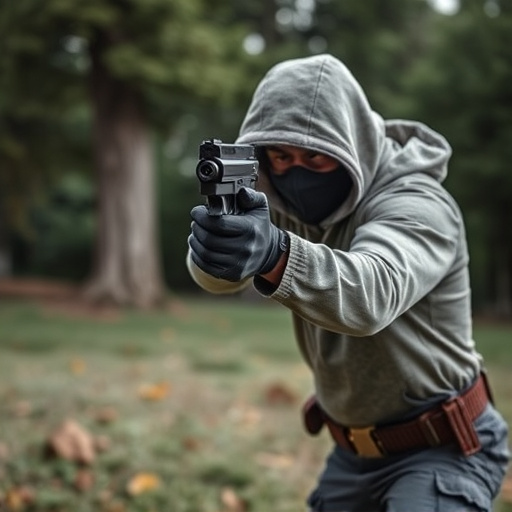Stun Gun Safety & Detection: Beginner’s Guide to Avoiding Unintended Activation
Stun guns, known as Electronic Control Devices (ECDs), offer non-lethal self-defense but raise publi…….
Stun guns, known as Electronic Control Devices (ECDs), offer non-lethal self-defense but raise public safety concerns due to their discreet designs. Beginners should understand their functionality and safety features, such as motion sensors and LED indicators, which help prevent accidental activation. Advanced detection methods like EMF sensors and machine learning algorithms are employed by security systems to identify stun guns, a growing issue in criminal activities. Safe handling practices, including regular inspection, maintenance, and knowledge of local laws, are essential. The legal status of stun gun ownership varies globally, requiring balanced regulations that protect rights while maintaining public safety. Future detection technologies will leverage sensor advancements, materials science, AI, and real-time communication with security systems to enhance overall security.
In today’s diverse landscape, understanding concealed stun gun detection is paramount for safety. This article explores the growing concern surrounding hidden weapons and cutting-edge technology designed to detect them. From a beginner’s guide on stun gun safety features to advanced detection methods, legal aspects, and innovative future solutions, we delve into crucial insights. Learn how to navigate this complex issue, ensuring peace of mind and enhanced security, especially for those new to stun guns.
- Understanding Stun Guns: A Beginner's Guide to Safety Features
- The Growing Concern: Concealed Weapons and Detection Technology
- Advanced Detection Methods: How Security Systems Spot Stun Guns
- Stun Gun Safety for Beginners: Tips to Avoid Unintentional Activation
- Legal Aspects: Regulations on Stun Gun Ownership and Detection
- Future of Stun Gun Detection: Innovations for Enhanced Security
Understanding Stun Guns: A Beginner's Guide to Safety Features

Stun guns, officially known as Electronic Control Devices (ECDs), are non-lethal weapons designed to incapacitate an assailant through electrical impulses, rendering them temporarily unconscious or disoriented. They offer individuals a means of self-defense, especially in situations where traditional self-defense tools might not be readily available or effective. For beginners considering stun guns as a safety measure, understanding the device’s functionality and its built-in safety features is paramount.
Many modern stun guns are equipped with various safety mechanisms to ensure responsible use. These include motion sensors that activate the device only when it detects an imminent threat, preventing accidental activation. Some models have safety switches, allowing users to turn them off instantly when not in use, while others incorporate LED indicators that signal battery life and activation status, enhancing user awareness. Additionally, training resources are readily available for beginners to learn proper usage, ensuring they handle stun guns safely and effectively.
The Growing Concern: Concealed Weapons and Detection Technology

The growing prevalence of concealed weapons, especially among individuals who may not have extensive training or experience in firearm handling, has sparked significant concern regarding public safety. With the availability of compact and easily concealable stun guns, often marketed as non-lethal alternatives to traditional firearms, there’s a pressing need to address detection challenges. These devices, while designed with safety features for beginners, can be hard to identify without proper training or specialized equipment.
The issue lies in the subtle nature of stun guns compared to conventional weapons. Their sleek and often unassuming designs make them easily miscible within everyday objects or accessories, posing a unique challenge for security personnel and law enforcement. This concern is further exacerbated by the fact that many stun guns operate silently, with no obvious signs of discharge, adding another layer of complexity in their detection.
Advanced Detection Methods: How Security Systems Spot Stun Guns

Advanced detection methods have been developed by security systems to identify stun guns, addressing a growing concern about their use in potential criminal activities. These innovative techniques go beyond basic metal detectors commonly associated with security checks. Modern security systems employ advanced sensor technologies and algorithms designed to recognize the unique electrical signals emitted by stun guns when activated. By analyzing these signals, security personnel can accurately detect stun guns concealed on individuals or within personal items, even in challenging environments like crowded public spaces or airports.
One such method involves using electromagnetic field (EMF) sensors that can pick up on the distinct EMF patterns generated by stun guns’ electrical components. This technology is particularly effective at identifying modern stun devices designed with safety features for beginners, which often employ advanced circuitry to minimize interference from everyday electronics. Additionally, machine learning algorithms are being integrated into security systems, enabling them to learn and adapt to new patterns, further enhancing the accuracy of stun gun detection.
Stun Gun Safety for Beginners: Tips to Avoid Unintentional Activation

Stun guns are powerful self-defense tools, but their use requires caution and awareness to ensure safe handling. For beginners, understanding how to properly use a stun gun is essential. One of the primary concerns is avoiding unintentional activation, which can be dangerous and even illegal in certain situations.
To prevent this, beginners should focus on understanding the safety features of their stun guns. Many modern models come equipped with safety mechanisms like trigger locks or motion sensors that deactivate the device when not in use. Regularly inspecting and maintaining your stun gun is also crucial. Always keep it in a secure case and store it away from children and pets. Familiarize yourself with local laws regarding stun gun possession and usage to avoid any legal repercussions.
Legal Aspects: Regulations on Stun Gun Ownership and Detection

The legal landscape surrounding stun gun ownership and detection varies significantly across jurisdictions, creating a complex web for both users and law enforcement. In many countries, owning a stun gun is permitted with certain restrictions based on age, background checks, and specific reasons for acquisition, such as personal protection or professional use in security roles. However, regulations can differ widely; some regions allow open carry, while others mandate concealed carry with stringent requirements for detection.
One growing concern is the emergence of stun guns with advanced safety features, often marketed towards beginners seeking non-lethal self-defense options. These devices may have built-in alarms or GPS tracking, raising questions about their potential to alert authorities or individuals in distress during an encounter. As technology advances, so too do the capabilities for both personal protection and law enforcement surveillance, underscoring the need for balanced regulations that respect individual rights while ensuring public safety.
Future of Stun Gun Detection: Innovations for Enhanced Security

The future of stun gun detection lies in continuous innovation aimed at enhancing security and ensuring public safety. As technology advances, we can expect more sophisticated devices that can accurately detect even concealed stun guns, which are often the preferred choice for beginners due to their discreet nature. These innovations may include improved sensor technologies, advanced materials capable of detecting subtle changes in electromagnetic fields, or even AI-driven systems that can analyze patterns and behavior to identify potential threats.
Additionally, integration of safety features into stun guns themselves could revolutionize detection methods. Manufacturers are already incorporating safety mechanisms like automatic shut-off switches and motion sensors to prevent accidental activation, making these weapons more user-friendly for beginners. Such devices could also communicate with nearby law enforcement or security systems, providing real-time data on the presence and location of stun guns in a given area, thereby improving overall security measures.
As we’ve explored, concealed stun gun detection is a complex issue in today’s security landscape. While advanced detection technologies offer growing promise, it’s crucial to balance effectiveness with privacy concerns. For individuals seeking stun gun safety as a beginner, understanding both the device’s features and legal regulations is paramount. Future innovations will undoubtedly enhance detection capabilities, but responsible ownership and education remain key to ensuring these tools are used safely and ethically. By staying informed about these evolving technologies and practicing prudent safety measures, users can leverage stun guns’ benefits while mitigating potential risks.


